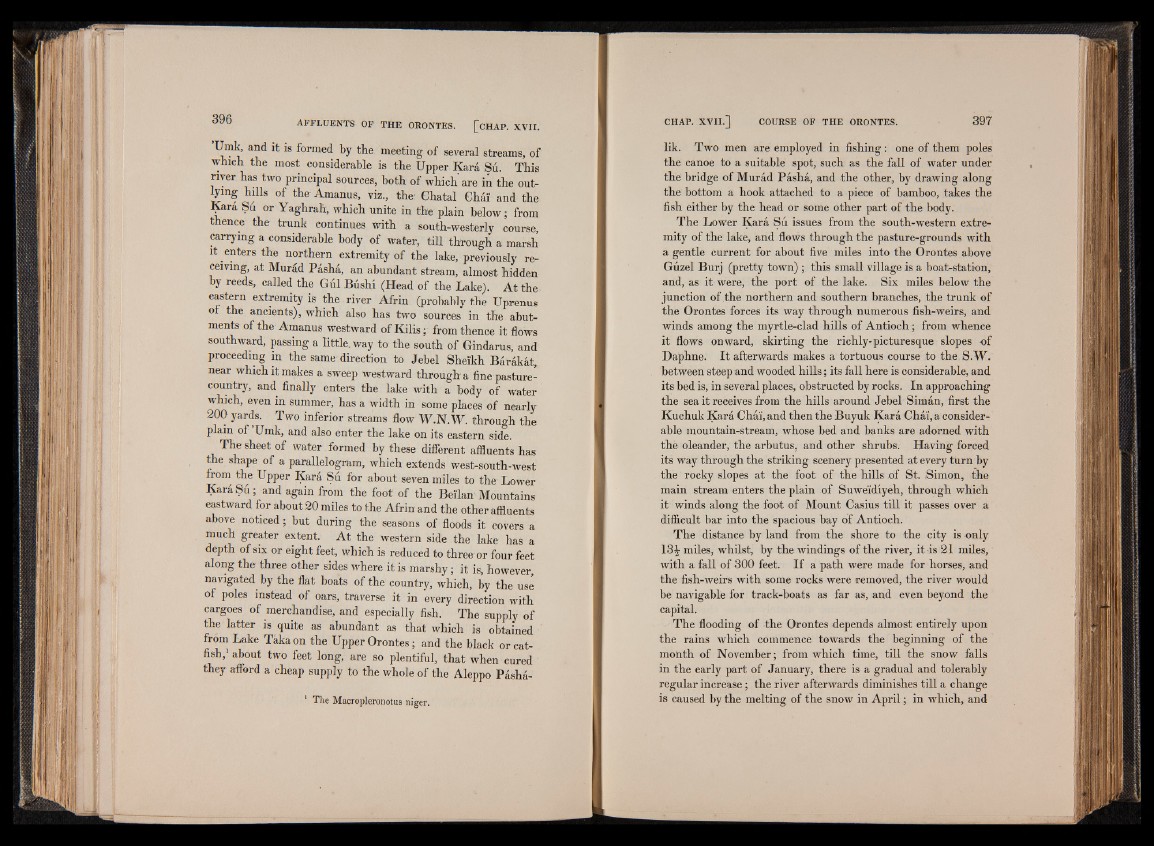
Vmk and it is formed by the meeting of several streams, of
which the most considerable is the Upper Kara Su. This
river has two principal sources, both of which' are in the outlying
hills of the Amanus, viz., the1 Ghatal Chai and the
J£ara Su or Yaghrah, which unite in the plain below; from
thence the trunk continues with a south-westerly course,
carrying a considerable body of water, till through a marsh
it enters the northern extremity of the lake, previously receiving,
at Murad Pasha, an abundant stream, almost hidden
by reeds, called the Gul Bushi (Head of the Lake). At the
eastern extremity is the river Afrin (probably the Uprenus
of the ancients), which also has two sources in the abutments
of the1 Amanus westward of K ilisfrom thence it flows
southward, passing a little, way to the south of Gindarus, and
proceeding in the same direction to Jebel Sheikh Barakat,
near which it makes a sweep westward through a fine pasture-
country, and finally enters the lake with a body of water
which, even in summer, has a width in some places of nearly
20(> yards. Two inferior streams flow W.N.W. through the
plain of ’Umk, and also enter the lake on its eastern side.
The sheet of water formed by these different affluents has
the shape of a parallelogram, which extends west-south-west
from the Upper Kara Su for about seven miles to the Lower
Kari-Sfi; and again from the foot of the Beilan Mountains
eastward for about 20 miles to the Afrin and the other affluents
above noticed; but during the seasons of floods it covers a
much greater extent. At the western side the lake has a
depth of six or eight feet, which is reduced to three or four feet
along the three other sides where it is marshy; it is, however,
navigated by the flat boats of the country, which, by the use
of poles instead of oars, traverse it in every direction with
cargoes of merchandise, and especially fish. The supply of
the latter is quite as abundant as that which is obtained
from Lake Taka on the Upper Orontes; and the black or catfish,
1 about two feet long, are so plentiful, that when cured
they afford a cheap supply to the whole of the Aleppo Pasha-
1 The Macropleronotus niger.
lik. Two men are employed in fishing : one of them poles
the canoe to a suitable spot, such as the fall of water under
the bridge of Murad Pasha, and the other, by drawing along
the bottom a hook attached to a piece of bamboo, takes the
fish either by the head or some other part of the body.
The Lower Kara Su issues from the south-western extremity
of the lake, and flows through the pasture-grounds with
a gentle current for about five miles into the Orontes above
Guzel Burj (pretty town) ; this small village is a boat-station,
and, as it were, the port of the lake. Six miles below the
junction of the northern and southern branches, the trunk of
the Orontes forces its way through numerous fish-weirs, and
winds among the myrtle-clad hills of Antioch; from whence
it flows onward, skirting the richly-picturesque slopes of
Daphne. It afterwards makes a tortuous course to the S.W.
between steep and wooded hills; its fall here is considerable, and
its bed is, in several places, obstructed by rocks. In approaching
the sea it receives from the hills around Jebel Siinan, first the
Kuchuk Kara Chai, and then the Buyuk Kara Cha'i, a considerable
mountain-stream, whose bed and banks are adorned with
the oleander, the arbutus, and other shrubs. Having forced
its way through the striking scenery presented at every turn by
the rocky slopes at the foot of the hills of St. Simon, the
main stream enters the plain of Suweldiyeh, through which
it winds along the foot of Mount Casius till it passes over a
difficult bar into the spacious bay of Antioch.
The distance by land from the shore to the city is only
13J- miles, whilst, by the windings of the river, it is 21 miles,
with a fall of 300 feet. If a path were made for horses, and
the fish-weirs with some rocks were removed, the river would
be navigable for track-boats as far as, and even beyond the
capital.
The flooding of the Orontes depends almost entirely upon
the rains which commence towards the beginning of the
mohth of November; from which time, till the snow falls
in the early part of January, there is a gradual and tolerably
regular increase; the river afterwards diminishes till a change
is caused by the melting of the snow in April; in which, and